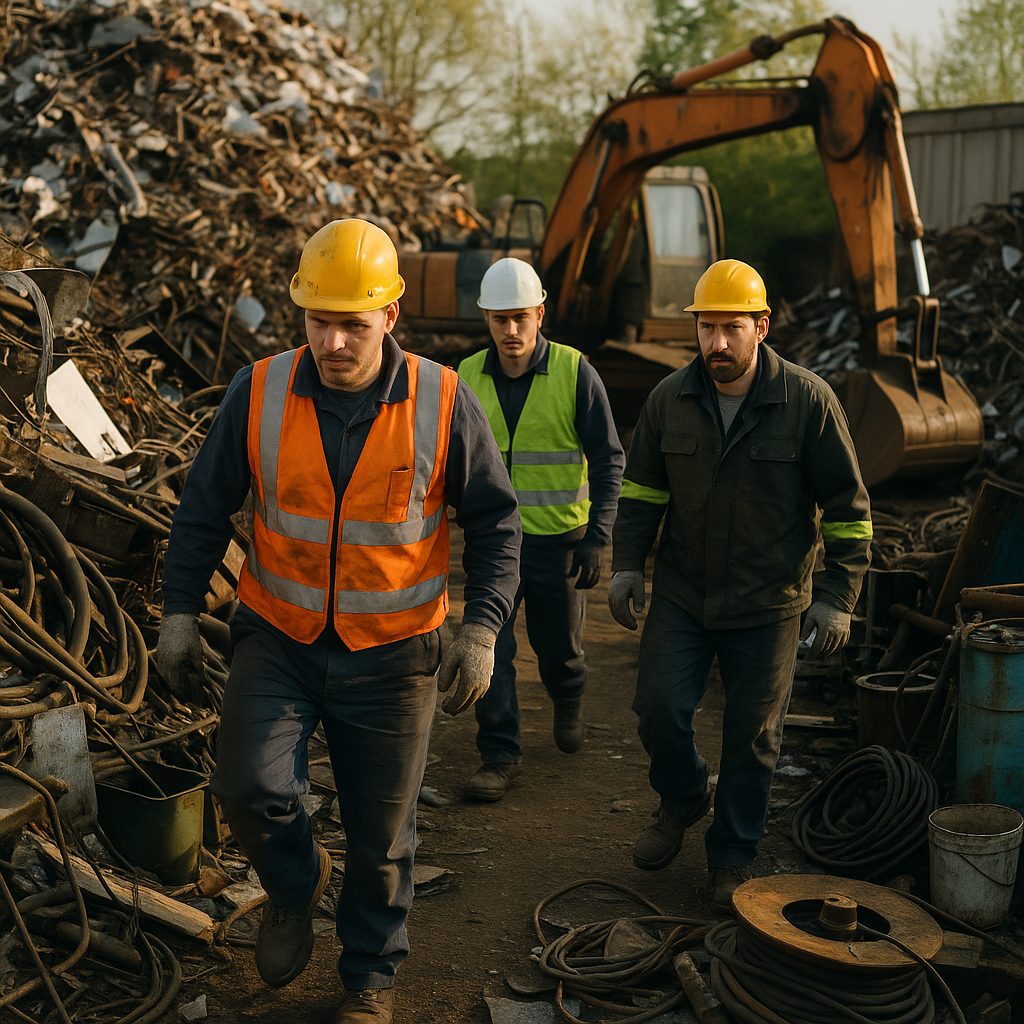5901 Botham Jean Blvd, Dallas, TX 75215
Industrial Scrap Management Process: Everything You Need to Know
October 16, 2025Industrial scrap management is the systematic process of handling, sorting, and processing waste materials generated during manufacturing operations. From metal scraps and plastic offcuts to wood remnants and packaging waste, these byproducts require proper management to prevent environmental harm and resource waste.
Every manufacturing facility produces some form of scrap. The difference between successful operations and struggling ones often lies in how effectively they handle these materials. Instead of viewing scrap as mere waste, forward-thinking companies recognize these byproducts as valuable resources that can be recovered, recycled, and sometimes sold.
The industrial scrap management process serves several critical functions. It helps manufacturing facilities reduce their environmental footprint by diverting materials from landfills and conserves natural resources by enabling the reuse of materials rather than extracting new raw resources.
How Does the Sorting and Processing of Industrial Scrap Work?

Sorting industrial scrap is a methodical process that starts with separating recyclable from non-recyclable materials. This fundamental sorting stage lays the groundwork for efficient resource recovery and waste reduction in the industrial recycling sector.
The primary sorting techniques involve a combination of mechanical and technological methods to effectively process different types of materials. Magnetic separation is one of the most economical and oldest methods for sorting recyclable materials, especially ferrous metals.
Magnetic Separation: The Workhorse of Metal Recovery
Magnetic separation uses magnetic fields to efficiently sort ferrous metals from non-magnetic debris. In scrap recycling facilities, large industrial magnets lift, handle, and load ferrous materials into selective piles of marketable products.
There are several types of magnetic separators used in industrial scrap processing:
- Drum magnetic separators – Used for high-volume ferrous recovery with consistent magnetic strength
- Overband magnets – Positioned above conveyor belts to remove ferrous metals from a material stream
- Magnetic head pulleys – Located at the end of conveyor systems to capture smaller ferrous particles
- Magnetic plates and blocks – Used for specific applications requiring targeted magnetic separation
Modern recycling operations heavily rely on these magnetic systems to manage what would otherwise require extensive manual labor. A drum magnetic separator can process large volumes of material continuously, ensuring efficient separation even with rapid material flow.
Processing Non-Ferrous Materials
For valuable non-ferrous metals like aluminum, copper, and stainless steel that don’t respond to conventional magnets, eddy current separators are used. These specialized machines create magnetic fields inducing electrical currents in conductive non-ferrous metals, causing them to be ejected from the material stream.
Infrared and X-ray technologies also play critical roles in sorting facilities, especially for distinguishing between different types of plastics and non-metallic materials often found mixed with industrial scrap.
Shredding and Compacting: Preparing Materials for Transport and Processing
After initial sorting, materials undergo shredding to reduce their size and increase density. Industrial shredders can process various materials including:
- Metal scrap from manufacturing operations
- Automotive components and sheet metal
- Electronic waste containing multiple materials
- Mixed industrial waste requiring size reduction
Shredding serves multiple purposes in the recycling process. It breaks down materials into manageable sizes, increases surface area for more efficient processing, and helps liberate different materials that may be attached or combined.
Following shredding, materials are typically compacted using balers or compactors. This step reduces transportation costs and storage space requirements while preparing the materials for their next processing stage.
The Role of Specialized Equipment and Trained Personnel
Efficient industrial scrap sorting and processing require both advanced equipment and skilled operators. Processing facilities invest in specialized machinery calibrated for specific material streams, while technicians must understand material properties and equipment capabilities to maximize recovery rates.
Quality control is maintained throughout the process, with regular sampling and testing to ensure that sorted materials meet industry specifications and customer requirements.
| Technology | Type | Advantages | Disadvantages |
|---|---|---|---|
| XRF | Non-destructive, Radiation-based | Precise identification of metal composition, Handheld and automated options | Concerns over radiation, Requires PPE and licensing, Limited in detecting light elements |
| LIBS | Minimally destructive, Laser-based | Rapid metal identification, No radiation, Effective for light metals | Less accurate compared to XRF for heavy metals, Minimal surface melting |
| Magnetic Separation | Magnetic-based | Efficient for ferrous metals, No radiation risks | Limited to magnetic materials |
| Eddy Current Separator | Magnetic induction | Effective for non-ferrous metals, High purity sorting | Cannot sort ferrous metals directly |
| Infrared and X-ray | Sensor-based | Effective for plastics and non-metallic materials, High speed and precision | Higher costs, Requires specialized equipment and training |
Modern industrial scrap processing facilities often combine these technologies in sequence to achieve the highest possible recovery rates. The process flow typically moves from coarse separation using magnetic and mechanical methods to progressively finer sorting using advanced sensors and specialized equipment.
This systematic approach to sorting and processing enables the industrial recycling sector to recover valuable resources from scrap while reducing landfill waste, supporting both economic and environmental sustainability goals.
What Are the Key Challenges in Industrial Scrap Management?

Industrial scrap management presents several significant obstacles for businesses aiming to implement effective recycling programs. These challenges often require strategic planning and innovative solutions. The complexity of these barriers varies across industries, but addressing them is essential for sustainable operations.
Complex waste streams represent one of the most persistent challenges in industrial recycling. Manufacturing processes typically generate diverse material mixtures that are difficult to separate efficiently. These streams often contain hazardous components that require specialized handling. For instance, electronic waste contains valuable metals like copper alongside hazardous materials such as lead and mercury, creating sorting difficulties that can reduce material recovery rates.
Studies indicate that approximately 70% of industrial waste is improperly sorted, resulting in recoverable materials like aluminum and steel ending up in landfills instead of recycling facilities. This contamination significantly reduces recycling efficiency and material value recovery. Organizations must implement precise separation techniques to maximize resource reclamation.
Financial Barriers to Effective Recycling
The substantial initial investment required for recycling infrastructure presents a significant hurdle for many businesses. Companies must allocate resources for specialized equipment, collection systems, and processing facilities. These costs can be prohibitive, particularly for smaller operations with limited capital resources.
Market volatility further complicates the economic viability of industrial recycling. When prices for virgin materials drop, recycled alternatives become less financially attractive, making it difficult to justify the substantial upfront investment. The recycling industry has experienced fluctuations in recent years, with IBISWorld reporting a compound annual growth rate decline of 2.1% over a five-year period.
Despite these challenges, companies that view recycling infrastructure as a long-term investment often discover cost savings through reduced disposal fees and potential revenue from selling recyclable materials. Additionally, several grant programs and tax incentives exist to help offset initial setup costs.
Human Factors in Recycling Success
Employee engagement represents a critical yet often overlooked aspect of successful industrial recycling programs. Without proper training and motivation, staff may contaminate recycling streams or fail to capture recyclable materials. Workers need clear guidelines on sorting procedures and handling protocols, particularly for potentially hazardous waste.
Safety concerns can also impact workforce participation in recycling initiatives. Employees face risks when handling certain materials or operating sorting equipment. These safety challenges require comprehensive training programs and appropriate protective measures to ensure worker wellbeing while maintaining recycling efficiency.
Organizations that implement regular training sessions, clear communication about proper disposal practices, and recognition programs for recycling participation typically achieve higher success rates. Simple visual reminders and accessible collection points throughout facilities can significantly improve compliance.
Supply Chain Coordination Challenges
Integrating recycling practices throughout the supply chain presents complex coordination difficulties. Effective industrial recycling requires alignment across multiple facilities, partners, and geographic locations. Each stage from product design through end-of-life handling must consider recyclability and material recovery.
Companies frequently struggle to standardize recycling procedures across diverse operations, particularly when working with partners who have varying levels of commitment to sustainability. This challenge intensifies for organizations with global supply networks spanning regions with different regulatory requirements.
Finding reliable markets for recycled materials adds another layer of complexity. Manufacturers may hesitate to incorporate recycled content due to concerns about quality consistency or regulatory compliance. These market access issues can create bottlenecks even when collection and processing systems function efficiently.
Forward-thinking companies address these challenges through collaborative approaches. By establishing clear sustainability expectations with suppliers, providing technical support to partners, and creating standardized procedures, organizations can achieve greater supply chain integration for their recycling efforts.
The technological limitations of current recycling methods present additional barriers. Some complex composites and multi-material products remain difficult to recycle efficiently using existing techniques. While innovations in material separation are advancing, many facilities operate with outdated equipment that cannot process newer material types. This technological gap creates a significant challenge for comprehensive industrial recycling programs.
Despite these substantial obstacles, industrial recycling continues to advance through innovative approaches and collaborative solutions. Organizations that successfully navigate these challenges not only reduce their environmental impact but often discover operational efficiencies and cost savings that strengthen their overall business performance.
What Are the Best Practices for Efficient Scrap Management?

Implementing effective scrap management requires a structured approach with clear procedures. Organizations that excel in this area typically follow proven strategies to reduce waste, enhance resource recovery, and support sustainability goals. These practices not only minimize environmental impact but also improve the bottom line through cost savings and increased material recovery.
Conduct Regular Waste Audits
Waste audits provide critical insights into your scrap generation patterns. Begin by analyzing your current waste streams to identify the types and volumes of materials being discarded. This process reveals opportunities for improvement and establishes a baseline for measuring progress.
During these audits, document the origin points of different scrap materials, their composition, and their current disposal methods. This data helps pinpoint processes generating excessive waste and highlights materials with high recovery potential. Many organizations find that conducting audits quarterly yields optimal results, allowing enough time to implement changes between assessments.
Regular audits also help track the effectiveness of your scrap management initiatives over time. By comparing current data with previous findings, you can identify trends, measure improvements, and adjust strategies accordingly.
Implement Source Reduction Strategies
Source reduction targets waste prevention at its origin. This approach focuses on minimizing scrap generation before materials enter the waste stream. Start by reviewing procurement practices to avoid overordering, and consider redesigning products or processes to use fewer raw materials.
For manufacturing operations, optimize production processes to reduce offcuts and residual waste. This might include investing in precision equipment, using digital design tools to maximize material usage, or implementing lean manufacturing principles to minimize excess.
Another effective strategy involves working with suppliers to reduce packaging waste or implement take-back programs for packaging materials. By addressing waste at its source, you can significantly decrease the volume of scrap requiring management downstream.
Invest in Proper Recycling Infrastructure
Efficient scrap management requires appropriate infrastructure for collection, sorting, and processing. Install clearly labeled collection bins throughout your facility, with separate containers for different material types like metals, plastics, paper, and hazardous waste.
Consider investing in processing equipment such as balers, shredders, or compactors to prepare materials for recycling. These tools can reduce transportation costs by decreasing the volume of materials and may increase the value of recyclable scrap by improving quality and purity.
For larger operations, creating dedicated recycling areas with appropriate storage facilities ensures materials remain separated and protected from contamination. Proper infrastructure not only streamlines the recycling process but also demonstrates your commitment to sustainable practices.
| Equipment | Function | Application |
|---|---|---|
| Shredders | Reduce size of materials | Metal scrap, automotive components, electronic waste |
| Scrap Shears | Cut metal to size | Steel bars, aluminum, mixed metals |
| Baling Presses | Compress loose scrap into dense bales | Transportation, storage efficiency, foundry operations |
| Eddy Current Separators | Separate non-ferrous metals | Aluminum, copper, brass |
| Material Handlers | Load and move bulk materials | Ferrous material sorting, large unit component processing |
Establish Clearly Marked Collection Points
Well-designed collection points form the foundation of successful scrap management. Place collection stations strategically throughout your facility, ensuring they’re easily accessible to staff yet do not interfere with operations. Each station should include clearly labeled bins for different material types.
Use color-coding and simple, visual signage to help employees quickly identify the appropriate bin for each type of scrap. Include examples of acceptable and unacceptable materials to minimize contamination. For specialized or hazardous materials, implement secure collection methods with appropriate containment.
Regular monitoring and maintenance of collection points helps prevent overflow and ensures materials are being properly sorted. This simple but effective practice significantly improves recycling rates and material quality.
Partner with Specialized Recycling Companies
Working with experienced recycling partners expands your capacity for proper materials management. These specialists have the expertise and equipment to handle various waste streams efficiently. When selecting a recycling partner, look for companies with strong environmental credentials and transparent reporting practices.
Specialized recyclers can often recover materials that might otherwise be discarded, extracting maximum value from your scrap. They may also provide insights into improving your internal sorting and collection processes based on their industry knowledge.
Establish clear communication channels with your recycling partners and regularly review performance metrics. This collaborative approach ensures continuous improvement of your scrap management program while supporting broader sustainability goals.
Arrange Compliant Transportation
Proper transportation is essential for maintaining the integrity of your recycling program. Work with licensed haulers who understand regulatory requirements, particularly for hazardous materials. Schedule regular pickups to prevent the accumulation of materials and minimize storage requirements.
Consider logistics efficiency when planning transportation. Consolidating shipments, optimizing routes, and ensuring vehicles are appropriately loaded can reduce transportation costs and associated environmental impacts. For some materials, specialized containers or handling procedures may be necessary to prevent contamination or damage during transit.
Maintain accurate records of all materials transported off-site, including dates, volumes, contents, and destinations. This documentation supports compliance efforts and provides valuable data for your waste audit program.
Maintain Detailed Documentation of Waste Streams
Comprehensive documentation forms the backbone of effective scrap management. Track the types, volumes, and sources of all waste materials generated. Document recycling rates, disposal methods, and the final destination of all materials leaving your facility.
Modern tracking systems can streamline this process through digital logging, barcoding, or automated reporting. These tools provide real-time visibility into your waste streams and simplify regulatory compliance reporting. Many organizations find that digital documentation improves accuracy and accessibility compared to paper-based systems.
Use your documentation to generate regular reports analyzing trends, identifying improvement opportunities, and demonstrating progress toward waste reduction goals. This information supports data-driven decision-making and helps justify investments in improved scrap management practices.
Implement Employee Training and Engagement Programs
The success of any scrap management program ultimately depends on employee participation. Develop comprehensive training programs that explain proper sorting procedures, the importance of waste reduction, and the environmental impact of effective recycling. Make this training part of new employee onboarding and offer refresher courses regularly.
Beyond basic training, foster a culture of sustainability through ongoing engagement initiatives. Recognize and reward departments or individuals who contribute to waste reduction goals. Share success stories and progress updates to maintain momentum and demonstrate the value of collective efforts.
Consider creating a green team with representatives from different departments to champion scrap management initiatives. This approach builds ownership across the organization and helps identify improvement opportunities from diverse perspectives.
How Can Companies Benefit from Effective Industrial Scrap Management?

Effective industrial scrap management provides substantial financial and environmental advantages for companies across various sectors. When executed properly, these systems convert what was once deemed waste into valuable resources. Companies that focus on scrap management quickly recognize its impact on their profitability and operational efficiency.
Cost Savings Through Resource Optimization
The most immediate benefit of efficient scrap management is significant cost reduction. By recycling and reusing scrap materials, companies lower their need for raw materials. This directly reduces procurement expenses and disposal costs, which continue to rise as landfill space becomes more limited.
Just-in-time production strategies, combined with material efficiency programs, can reduce material waste by 15-30% in manufacturing settings. Companies with robust scrap management programs often report overall cost reductions of 5-10% in their production processes through better resource utilization.
Reusing scrap materials within production cycles creates closed-loop systems where materials that would have been discarded are recaptured and reintroduced. This practice minimizes the need for virgin materials while streamlining operational expenses.
| Aspect of Scrap Management | Cost Savings Impact |
| Material Efficiency Programs | Reduces material waste by 15-30% in manufacturing environments, leading to overall cost reductions |
| Recycling and Reusing Scrap | Decreases the need for raw materials and lowers procurement expenses |
| Reduced Disposal Costs | Significant reduction as landfill space becomes more limited and disposal costs rise |
| Closed-loop Production Cycles | Minimizes need for virgin materials, streamlining operational expenses |
| Potential Revenue from Scrap | Recovery of 30-80% of original material value in industries like metal fabrication |
Regulatory Compliance and Risk Mitigation
Industrial operations face increasingly stringent environmental regulations. Effective scrap management helps companies comply with local, state, and federal requirements governing waste disposal and recycling. This proactive approach prevents potential fines and legal issues that can damage finances and reputation.
Many regions have implemented specific regulations regarding industrial waste management. Companies with proper scrap management systems in place can easily demonstrate compliance during inspections. This reduces the risk of penalties and operational disruptions from regulatory actions.
Beyond avoiding fines, compliant scrap management reduces liability risks related to improper waste disposal. This protects companies from potential lawsuits and remediation costs that can arise from environmental contamination incidents.
Creating Additional Revenue Streams
What many companies overlook is that scrap materials often retain significant value. Metal scraps, certain plastics, and other industrial byproducts can be sold to recyclers or other manufacturers, creating new revenue streams from materials previously treated as waste.
Some manufacturing operations have transformed their scrap management programs into profit centers that generate substantial returns. In the metal fabrication industry, for example, properly sorted and processed scrap can recover 30-80% of the original material value depending on material type and market conditions.
Strategic partnerships with recycling facilities can maximize the value recovered from scrap materials. These relationships often include favorable pricing agreements based on volume and quality.
Enhanced Corporate Social Responsibility
Modern consumers and business partners increasingly favor companies with demonstrated environmental commitments. Effective scrap management enhances a company’s corporate social responsibility profile, improving brand reputation and customer loyalty in an eco-conscious marketplace.
Companies with strong sustainability programs, including scrap management, report better employee engagement and retention rates. Workers prefer employers whose values align with environmental stewardship and responsible resource management.
Many businesses leverage their scrap management achievements in marketing campaigns, highlighting resource conservation efforts to differentiate themselves from competitors. This strategy resonates with the growing segment of environmentally conscious consumers.
Environmental Benefits and Carbon Footprint Reduction
The environmental benefits of proper scrap management extend far beyond regulatory compliance. By reducing landfill waste, companies help conserve limited landfill space and prevent potential soil and water contamination from industrial materials.
Recycling scrap materials requires significantly less energy than processing raw materials. This energy efficiency translates to lower greenhouse gas emissions across the supply chain. Metal recycling, for instance, uses up to 95% less energy than producing metals from virgin ores.
Effective scrap management contributes to resource conservation by reducing the need for mining, logging, and other resource extraction activities that have substantial environmental impacts. This preserves natural habitats and biodiversity while ensuring more sustainable resource availability for future production needs.
Conclusion: The Future of Industrial Scrap Management
The future of industrial scrap management combines technological innovation with sustainability principles. AI-driven sorting systems now achieve over 90% accuracy and process materials faster than manual methods. These smart technologies, combined with circular economy approaches that treat waste as a resource, are transforming how manufacturing companies handle scrap materials.
As environmental regulations tighten and public awareness of sustainability grows, effective scrap management becomes a competitive advantage rather than merely a compliance requirement. Forward-thinking companies are already adopting AI-powered monitoring systems, blockchain tracking for material transparency, and adaptive manufacturing techniques that minimize waste from the start. These innovations not only reduce environmental impact but often deliver significant cost savings through resource efficiency.
For expert guidance on implementing these advanced scrap management solutions for your business, contact Okon Recycling at 214-717-4083.
